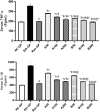Gastroprotective and anti-Helicobacter pylori potentials of essential oils from the oleoresins of Araucaria bidwillii and Araucaria heterophylla
- PMID: 36542210
- PMCID: PMC9768391
- DOI: 10.1007/s10787-022-01112-w
Gastroprotective and anti-Helicobacter pylori potentials of essential oils from the oleoresins of Araucaria bidwillii and Araucaria heterophylla
Abstract
Plant resins or oleoresins comprise a chemically complex mixture of different classes of compounds. Oleoresin of the genus Araucaria combines essential oil (EO) and resin. It possesses gastroprotective, cytotoxic, and timicrobial, antipyretic, and anti-inflammatory activities. The study aimed to investigate the EOs from the oleoresins of two Araucaria species, A. bidwillii and A. heterophylla, chemically and biologically for their gastroprotective, anti-inflammatory, antioxidant, and anti-Helicobacter pylori potentials. The chemical composition of both species cultivated in Egypt was analyzed with GC-MS and compared with those cultivated abroad using principal component analysis (PCA). There were 37 and 17 secondary metabolites identified in A. heterophylla and A. bidwillii, respectively. The EOs of both species showed a pronounced inhibitory effect on Helicobacter pylori activity in vitro. The gastroprotective effect was assessed in vivo using ethanol-induced gastric ulcer model in rats. Inflammatory cytokines, oxidative stress, and the nuclear factor-kappa B (NF-κB) biomarkers were assessed in the stomach tissues. The ulcer index and percentage of ulcer protection were determined. Stomach sections were examined histopathologically by staining with (H/E) and periodic acid Schiff (PAS). Moreover, the proliferative index was determined using the Ki-67 immunostaining. The treatment of rats with EOs (50, 100, and 200 mg/kg, orally) 1 hour prior to ethanol administration showed promising gastroprotective, anti-inflammatory, and antioxidant potentials. These findings declared the gastroprotective role played by both EOs with the superiority of A. bidwillii over A. heterophylla via modulation of oxidative stress/NF-κB/inflammatory cytokines. Their use can be recommended to protect against the recurrence of peptic ulcers.
Keywords: Anti-Helicobacter pylori activity; Anti-inflammatory effect; Antioxidant effect; Araucaria; Gastroprotective activity; Resin oil.
© 2022. The Author(s).
Conflict of interest statement
The authors have no relevant financial or non-financial interests to disclose.
Figures










Similar articles
-
Gastroprotective effects of Erythrina speciosa (Fabaceae) leaves cultivated in Egypt against ethanol-induced gastric ulcer in rats.J Ethnopharmacol. 2020 Feb 10;248:112297. doi: 10.1016/j.jep.2019.112297. Epub 2019 Oct 10. J Ethnopharmacol. 2020. PMID: 31606535
-
Gastroprotective potential of red onion (Allium cepa L.) peel in ethanol-induced gastric injury in rats: Involvement of Nrf2/HO-1 and HMGB-1/NF-κB trajectories.J Ethnopharmacol. 2024 Jan 30;319(Pt 1):117115. doi: 10.1016/j.jep.2023.117115. Epub 2023 Sep 1. J Ethnopharmacol. 2024. PMID: 37659760
-
BST-104, a Water Extract of Lonicera japonica, Has a Gastroprotective Effect via Antioxidant and Anti-Inflammatory Activities.J Med Food. 2019 Feb;22(2):140-151. doi: 10.1089/jmf.2018.4231. Epub 2019 Jan 24. J Med Food. 2019. PMID: 30676853
-
Gastroprotective Efficacy of North African Medicinal Plants: A Review on Their Therapeutic Potential for Peptic Ulcers.Food Sci Nutr. 2024 Oct 22;12(11):8793-8824. doi: 10.1002/fsn3.4536. eCollection 2024 Nov. Food Sci Nutr. 2024. PMID: 39619964 Free PMC article. Review.
-
Essential Oils and Their Major Compounds in the Treatment of Chronic Inflammation: A Review of Antioxidant Potential in Preclinical Studies and Molecular Mechanisms.Oxid Med Cell Longev. 2018 Dec 23;2018:6468593. doi: 10.1155/2018/6468593. eCollection 2018. Oxid Med Cell Longev. 2018. PMID: 30671173 Free PMC article. Review.
Cited by
-
Neuroprotective potential of Erigeron bonariensis ethanolic extract against ovariectomized/D-galactose-induced memory impairments in female rats in relation to its metabolite fingerprint as revealed using UPLC/MS.Inflammopharmacology. 2024 Apr;32(2):1091-1112. doi: 10.1007/s10787-023-01418-3. Epub 2024 Jan 31. Inflammopharmacology. 2024. PMID: 38294617 Free PMC article.
-
A First Metabolite Analysis of Norfolk Island Pine Resin and Its Hepatoprotective Potential to Alleviate Methotrexate (MTX)-Induced Hepatic Injury.Pharmaceuticals (Basel). 2024 Jul 22;17(7):970. doi: 10.3390/ph17070970. Pharmaceuticals (Basel). 2024. PMID: 39065818 Free PMC article.
-
Gastroprotective effect of Arabincoside B isolated from Caralluma arabica against ethanol-induced gastric injury via modulating oxidative stress/SP/NK-1R/NF-κB loop.Inflammopharmacology. 2025 Aug;33(8):4859-4869. doi: 10.1007/s10787-025-01885-w. Epub 2025 Aug 7. Inflammopharmacology. 2025. PMID: 40775122 Free PMC article.
-
HPLC-HRMS/MS and anti-inflammatory effects of bunya pine resin through multifaceted pathway modulation: NUMB/NOTCH1/HES1/mTOR/ PI3K/HMGB1 signaling cascades.Inflammopharmacology. 2025 Mar 31. doi: 10.1007/s10787-025-01660-x. Online ahead of print. Inflammopharmacology. 2025. PMID: 40163273
References
-
- Abdelall EKA, Lamie PF, Ali WAM. Cyclooxygenase-2 and 15-lipoxygenase inhibition, synthesis, anti-inflammatory activity and ulcer liability of new celecoxib analogues: determination of region-specific pyrazole ring formation by NOESY. Bioorg Med Chem Lett. 2016;26:2893–2899. doi: 10.1016/j.bmcl.2016.04.046. - DOI - PubMed
-
- Abdelhameed MF, Asaad GF, Ragab TI, Ahmed RF, El Gendy AE-NG, Abd El-Rahman SS, et al. Oral and topical anti-inflammatory and antipyretic potentialities of Araucaria bidiwillii shoot essential oil and its nanoemulsion in relation to chemical composition. Molecules. 2021;26:5833. doi: 10.3390/molecules26195833. - DOI - PMC - PubMed
-
- Adams RP. Identification of essential oil components by gas chromatography/mass spectrometry. 4. Carol Stream: Allured Publishing Corporation; 2007.
MeSH terms
Substances
LinkOut - more resources
Full Text Sources
Miscellaneous
